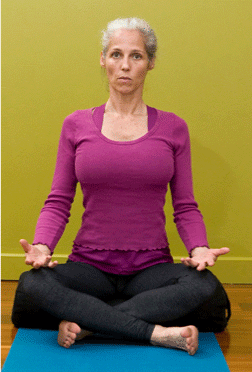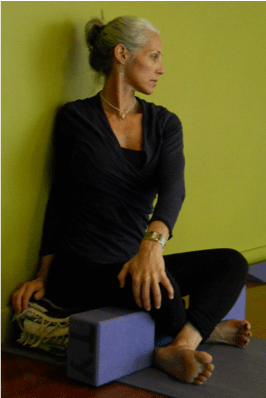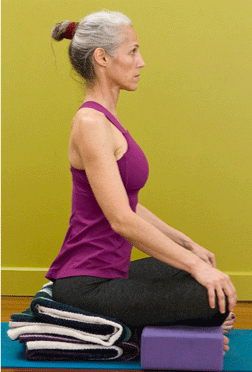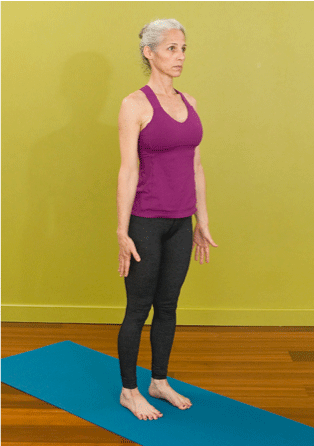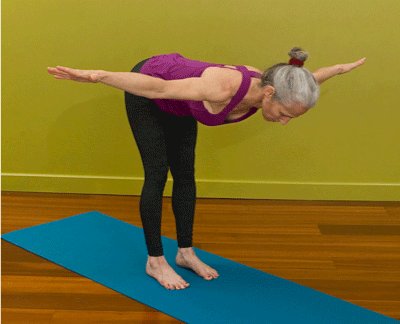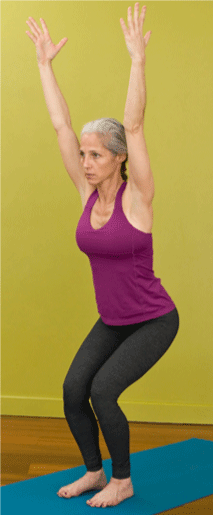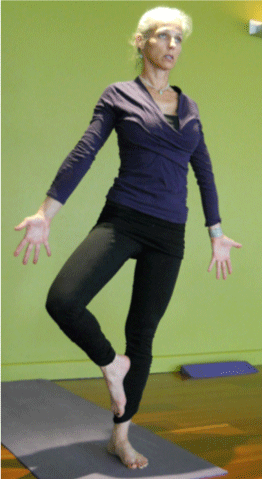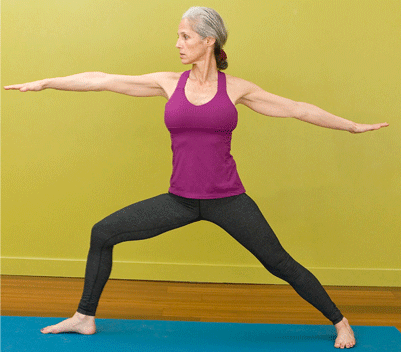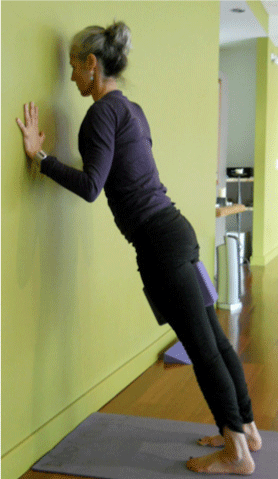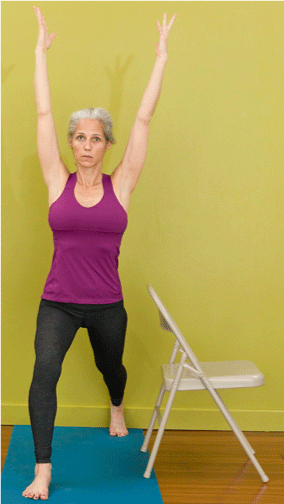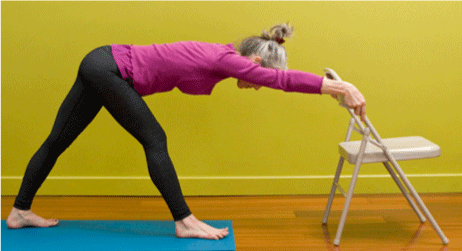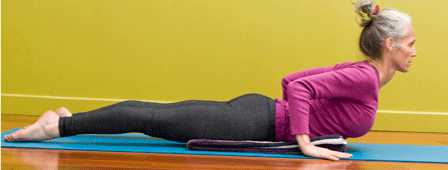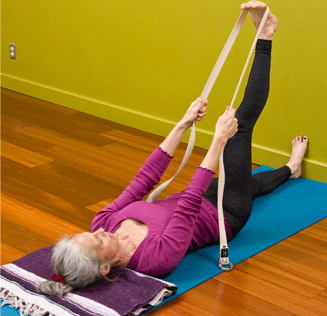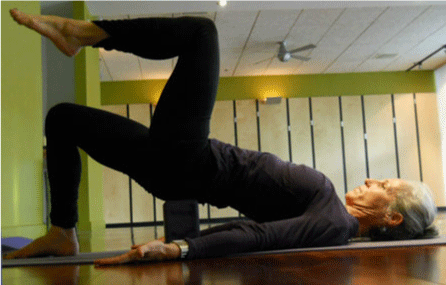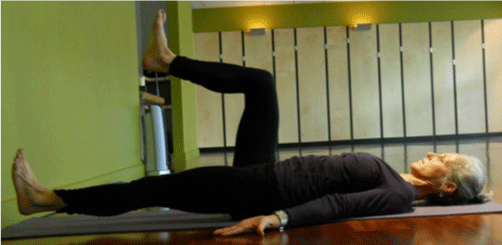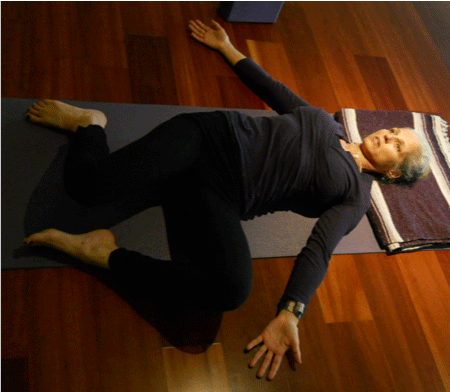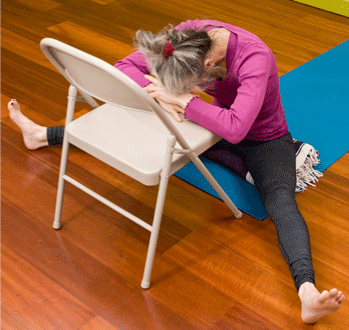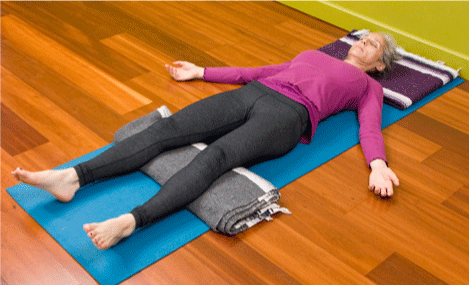Illustration of Posture |
English Name |
Description of pose |
|
Opening Postures |
||
|
Crossed legs on floor |
A seated posture on the floor, with back leaning against a wall, legs crossed at the mid-shins, blankets underneath hips and blocks underneath knees for support |
|
Seated Twist on floor |
A cross-legged seated posture, on floor; thoracic and cervical spine are axially rotated to the right and then to left, using one hand on knee and one hand on floor to assist rotation |
|
Cat-cow, seated |
A seated posture in chair, sitting tall with hands on knees; fluid alternation between spinal extension and flexion |
|
Mountain Pose |
Standing tall with hands at sides and feet hip width apart |
|
Partial Sun Salute |
Standing tall, transition to standing forward bend with knees extended and up to 90° of hip flexion (anteriorly) |
|
Middle Sequence |
||||
|
Chair |
A standing posture that emulates sitting in a chair, hips flexed to a maximum of 90° (anteriorly) and shoulders flexed to maximum of 180° Advancement from series I: no support from the wall |
||
|
Tree |
A one-legged standing balance, with non-weight bearing hip externally rotated to approximately 45° Advancement from Series I: non-weight bearing foot placed on medial ankle of the support leg; only stand on one leg and no use of external chair support (if feasible) |
||
|
Warrior II |
A lateral lunge, with forward hip externally rotated and knee flexed to approximately 45° (posteriorly); rear hip is internally rotated, rear foot turned in 30° Advancement from Series 1: Both arms abducted to 90°, with shoulders in neutral rotation; rear foot not braced against the angle made by the junction of the floor and wall |
||
|
Wall-Plank |
A standing pushup, facing the wall Advancement from Series 1: hands placed more caudally, mid-way between shoulders and waist; feet placed farther from wall, approximately 6 inches more than arm’s distance |
||
|
One-Legged Balance |
A single-leg stand with back resting on wall for support; non-support leg knee flexed to 90° (posteriorly), hip flexed to 90° (anteriorly) and foot pressed into block; shoulders flexed to a maximum of 180° |
||
|
Crescent |
A forward lunge, with heel braced against the wall, front knee flexed to a maximum of 90° and rear hip and knee extended; both shoulders flexed to a maximum of 180°, with external rotation |
||
|
Side Stretch |
A standing forward bend, with feet in semi-tandem position, hip-width apart. As much distance placed between front and rear foot as is comfortable Modification from Series I: hands placed on back of a chair; flex shoulders and slide chair away until anterior hip is flexed to a maximum of 90° (anteriorly); neutral spine is maintained |
||
|
Chair Twist |
A seated twist, on a firm chair; feet are planted on ground hip-width apart, thoracic and cervical spine are axially rotated to right and then to left |
||
|
Cobra |
A prone back extension; with blanket under hips and lower ribs, palms are pressed to the floor beneath shoulders, elbows are bent, scapulae are retracted and depressed Advancement from Series 1: Hand position placed lower, at approximately mid-thorax |
||
|
Recumbent Leg Stretch |
A recumbent hip flexion posture; extended right leg is flexed at the hip to a maximum of 90° (anteriorly) while the other leg remains extended and pressing into the floor; repeat on opposite side (Yoga strap is used on flexed leg) |
||
|
Bridge, with hip flexion |
A recumbent back extension and hip flexion; from a recumbent (supine) position with knees flexed to 45° (posteriorly), torso is elevated as hips are moved into bilateral extension |
||
|
Abdominal Cultivation |
A recumbent abdominal strengthening position; bilateral hips and knees are flexed to 90°, and feet are off of the floor. Then hips are extended to a maximum of approximately 120° (anteriorly); extension and flexion of hips are alternated |
||
|
Finishing Postures |
||||
|
Hip Flexor Stretch |
A recumbent twist; starting posture is arms in abduction, shoulders in external rotation, feet mat-width apart, and knees flexed to 45° (posteriorly); then knees are allowed to slowly drop toward the right. A blanket or block support is used under knees as needed. |
||
|
Wide-legged Seated Forward Bend |
A seated forward bend on the floor; forehead rests on chair, hips are at 90° of flexion (anteriorly) and legs are in abduction (approximately 45°). Blankets are used underneath hips and forehead and blocks are used underneath knees for support as needed |
||
|
Corpse pose |
Recumbent complete relaxation with normal breathing |
||
